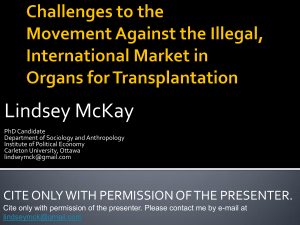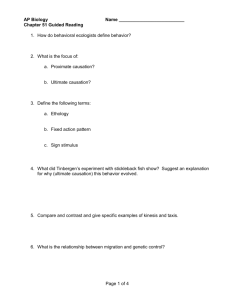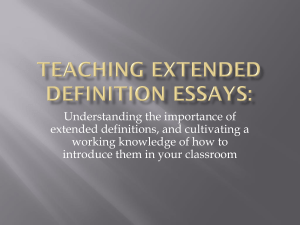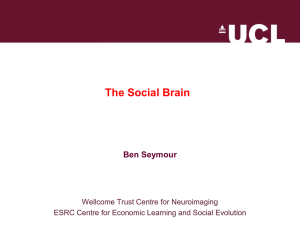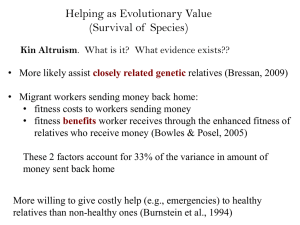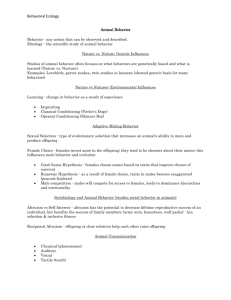Altruism in Experiments - UC San Diego Department of Economics
advertisement
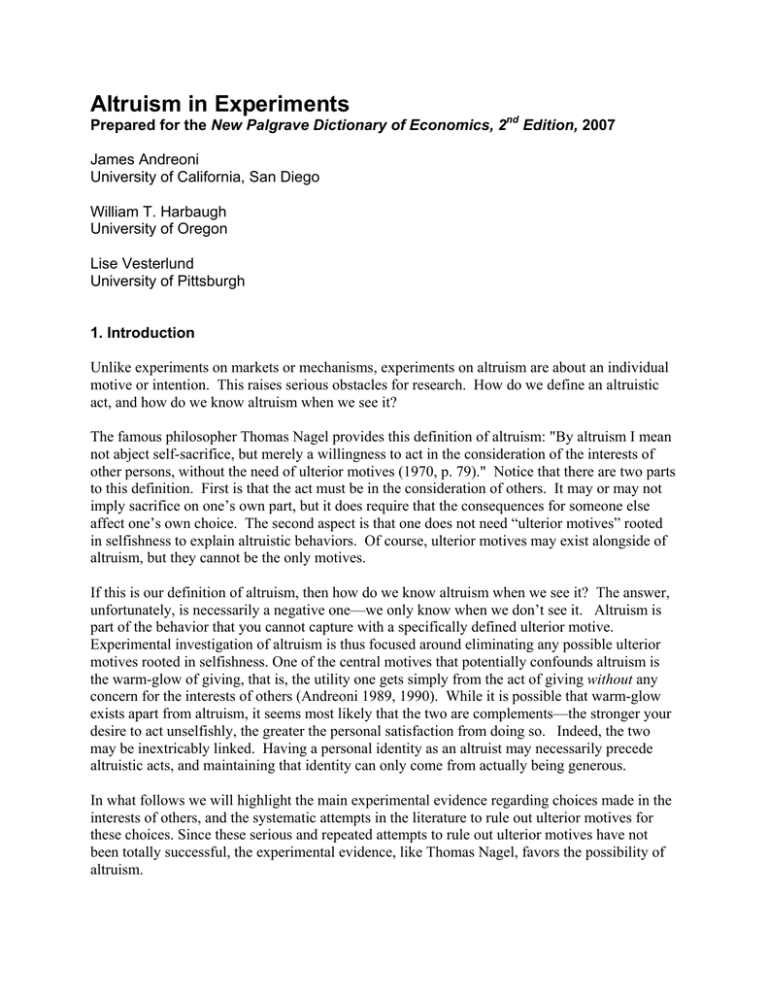
Altruism in Experiments Prepared for the New Palgrave Dictionary of Economics, 2nd Edition, 2007 James Andreoni University of California, San Diego William T. Harbaugh University of Oregon Lise Vesterlund University of Pittsburgh 1. Introduction Unlike experiments on markets or mechanisms, experiments on altruism are about an individual motive or intention. This raises serious obstacles for research. How do we define an altruistic act, and how do we know altruism when we see it? The famous philosopher Thomas Nagel provides this definition of altruism: "By altruism I mean not abject self-sacrifice, but merely a willingness to act in the consideration of the interests of other persons, without the need of ulterior motives (1970, p. 79)." Notice that there are two parts to this definition. First is that the act must be in the consideration of others. It may or may not imply sacrifice on one’s own part, but it does require that the consequences for someone else affect one’s own choice. The second aspect is that one does not need “ulterior motives” rooted in selfishness to explain altruistic behaviors. Of course, ulterior motives may exist alongside of altruism, but they cannot be the only motives. If this is our definition of altruism, then how do we know altruism when we see it? The answer, unfortunately, is necessarily a negative one—we only know when we don’t see it. Altruism is part of the behavior that you cannot capture with a specifically defined ulterior motive. Experimental investigation of altruism is thus focused around eliminating any possible ulterior motives rooted in selfishness. One of the central motives that potentially confounds altruism is the warm-glow of giving, that is, the utility one gets simply from the act of giving without any concern for the interests of others (Andreoni 1989, 1990). While it is possible that warm-glow exists apart from altruism, it seems most likely that the two are complements—the stronger your desire to act unselfishly, the greater the personal satisfaction from doing so. Indeed, the two may be inextricably linked. Having a personal identity as an altruist may necessarily precede altruistic acts, and maintaining that identity can only come from actually being generous. In what follows we will highlight the main experimental evidence regarding choices made in the interests of others, and the systematic attempts in the literature to rule out ulterior motives for these choices. Since these serious and repeated attempts to rule out ulterior motives have not been totally successful, the experimental evidence, like Thomas Nagel, favors the possibility of altruism. 2. Laboratory Experiments with Evidence of Altruism. In describing the games below, we adopt the convention of using Nash equilibrium to refer to the prediction that holds if all subjects are rational money-maximizers. 2.1 Prisoners’ Dilemma There have been thousands of studies using Prisoner’s Dilemma (PD) games in the psychology and political science literatures, all exploring the stubborn nature of cooperation (Kelley and Stahelski, 1970). Roth and Murnigham (1978) explored PD games under paid incentives and with a number of different payoff conditions. Their study confirmed to economists that cooperation is robust. Skeptics noted, however, that cooperation need not be caused by altruism. First, inexperience and initial confusion may cause subjects to cooperate. Second, subjects in a finitely repeated version of the game may cooperate if they each believe there is a chance someone actually is altruistic. Behaviorally this “sequential equilibrium reputation hypothesis” (Kreps, et al., 1982) does not actually require subjects to be altruistic, but only that they believe that they are sufficiently likely to encounter such a person. Andreoni and Miller (1993) explore these two factors by asking subjects to play 20 separate 10period repeated PD games. A control treatment had subjects constantly changing partners, thus unable to build reputations. They find significant evidence for reputations, but that these alone cannot explain the level of cooperation, especially at the end of the experiment. Rather, they estimate that about 20% of subjects actually need to be altruistic to support the equilibrium findings. This finding is corroborated in other repeated games, such as Camerer and Weigelt’s (1988) moral hazard game, McKelvey and Palfrey’s (1992) centipede game, and in a two-period PD of Andreoni and Samuelson (2006). 2.2. Public Goods Linear public goods games have incentives that make them resemble a many person PD game. Individuals have an endowment m which they each must allocate between themselves and a public account. Each of the n members of the group earns α for each dollar allocated to the public account. By design, 0 < α < 1 so giving nothing is a dominant strategy, but αn>1 so giving m is Pareto efficient. The results of these games are that average giving is significantly above zero, even as we change n, m and α (Isaac and Walker, 1988, Isaac, Walker and Williams, 1994) and whether the play is with the same group of “partners” or with randomly changing groups of “strangers” (Andreoni, 1988). Hence, reputations play little role in public goods games (Andreoni and Croson, 2008, Palfrey and Prisbrey, 1996). In his review of this literature, Ledyard (1995) notes that with a dominant strategy of giving zero, any error or variance in the data could mistakenly be viewed as altruism. Thus, to determine what drives giving one needs confirm that subjects understand the dominant strategy but choose to give anyway. Andreoni (1995) develops a design to separate “kindness” from “confusion” in linear public goods games. Rather than paying subjects for their absolute performance, in one treatment he paid subjects by their relative performance. Converting subjects’ ranks into their payoffs converts a positive-sum game to a zero-sum game. It follows that even altruists have no incentive to cooperate when paid by rank (that is, under the usual definition of altruism where people love themselves at least as much as they love others). Cooperation by subjects in the treatment group, therefore, provides a measure of confusion. Andreoni finds that both kindness and confusion are significant, and about half of all cooperation in public goods games is from people who understand free riding but choose to give anyway. Establishing that giving is deliberate, however, doesn’t necessarily mean it is based in altruism. It could, instead, be from warm-glow. Two papers, using similar experimental designs but different data analysis methods, explore this question by separating the marginal net return that a gift to the public good has for the giver and for the recipient. The “internal return” experienced by the giver should affect warm-glow and altruism, but the “external return” received by the others only affects altruism. Palfrey and Prisbrey (1997) find that warm-glow dominates altruism, while Goeree, Holt, and Laury (2002) find mostly altruism. Combining this evidence, it appears that both motives are likely to be significant. Another way to test for the presence of altruism and warm-glow is to choose a manipulation that would have different predictions in the two regimes. Andreoni (1993) looks at the complete crowding out hypothesis, which states that a lump sum tax, used to increase government spending on a public good, will reduce an altruist’s voluntary contributions by the amount of the tax. He employs a public goods game with an interior Nash equilibrium. Suppose subjects care only about the payoffs of other subjects (altruism). Then if we force subjects to make a minimum contribution below the Nash equilibrium, this should simply crowd out their chosen gift, leaving the total gift unchanged. If they get utility from the act of giving (warm-glow), by contrast, crowding out should be incomplete. Andreoni finds crowding at 85%, which is significantly different from both 0 and 100%. This confirms the findings from the last paragraph; both warm-glow and altruism are evident in experiments on public goods. Similar findings are presented in Bolton and Katok (1998) and Eckel, Grossman, and Johnston (2005). 2.3. Dictator Games This line of research began with the ultimatum game, where a proposer makes an offer on the split of a sum of money. If the responder accepts, the offer is implemented, while if she rejects both sides get nothing. Guth, Schmittberger, and Schwarze (1982) find that proposers strike fair deals and leave money on the table. Is this altruism, or just fear of rejection? To answer this question Forsythe, et al. (1994) also examine behavior in a dictator game which cuts out the second stage, leaving selfish proposers free to keep the whole pie for themselves, and leaving altruists unconstrained to give a little or a lot. While keeping the entire endowment is the modal choice in the dictator game, a significant fraction of people give money away. On average, people share about 25% of their endowment. This seems to indicate significant altruism. Again, researchers have explored numerous non-altruistic explanations. One is that, while the dictator’s identity is unknown to the recipient, it is not unknown to the researcher. This lack of “social distance” could cause the selfish but self-conscious subjects to give when they would prefer not to. Hoffman et al. (1994) take elaborate steps to increase the anonymity and confidentiality of the subjects so that even the researcher can’t know their choices for sure. They find that this decreases giving to about 10% of endowments. However, this “double anonymous” methodology create problems of its own. Bolton, Katok and Zwick (1998) argue that greater anonymity makes the participants skeptical about whether the transfers will be carried out. Bohnet and Frey (1999) find that reducing the social distance increases equal splits greatly, but in their anonymous treatments giving again averages 25%. (See also Rege and Telle, 2004). Andreoni and Miller (2002) take a different approach. They note that if altruism is a deliberate choice, then it should follow the neoclassical principles of revealed preference. They gave subjects a menu of several dictator “budgets,” each with different “incomes” and different “prices” of transferring this income to another anonymous subject. By checking choices against the Generalized Axiom of Revealed Preference, they show that indeed most subjects are rational altruists, that is, they have consistent and well-behaved preferences for altruistic giving in a dictator game. They also show substantial heterogeneity across subjects, with preferences ranging from utilitarian (maximizing total payments to both subjects) to Rawlsian (equalizing payments to both subjects). Interestingly, men and women are on average equally altruistic in this study, but vary significantly in response to price. Andreoni and Vesterlund (2001) show that men are more likely to be utilitarian, and women are more likely to be Rawlsian. This implies that men are significantly more generous when giving is cheap (that is, it costs the giver less than one to give one), but women are significantly more altruistic when giving is expensive (costs greater than or equal one to give one). Which is the fairer sex, therefore, depends on the price of giving (see also Eckel and Grossman, 1998, on dictator games when the price is one). 2.4 Trust Games and Gift Exchange When someone buys a loaf of bread from a baker, there is a moment when one party has both the bread and the money and the incentive to take both. Why don’t they? Similarly, why are some car mechanics truthful, and why do some workers put in an honest effort even when they aren’t monitored? These questions have been studied under names of trust games and gift exchange. In the trust game, two players are endowed with M each. A sender chooses to pass x to a receiver. A receiver receives kx, where k > 1. The receiver then chooses a y to pass back to the sender. Senders earn M – x + y, while receivers earn M + kx - y. Since y = 0 is a dominant strategy for receivers, x = 0 is the subgame perfect equilibrium strategy for senders. That is, since the baker keeps both the bread and the money, no exchange is attempted. Despite this dire prediction, x and y are often positive, and y is typically increasing in x. While there is tremendous variance, the average y is often slightly below the average x (Berg, Dickhaut, and McCabe, 1995). The gift exchange game is a non-linear version of the trust game above. Fehr, Kirchsteiger, and Riedl (1993) adapted the Akerlof (1982) labor market model of efficiency wages. Some subjects play the roles of firms and offer labor contracts to workers. The contracts stipulate a wage and an expected effort level of workers. Since effort is costly and unobservable, it should be minimal. Knowing this, wages should be low. However, they find wages are high and effort rises with the wage offer, just as Akerlof predicted. Trust and gift exchange games are often used to argue for the importance of reciprocity. Reciprocity is, however, an ulterior motive—giving in order to either generate an obligation or relieve one is not altruism by the definition in our introduction. How much of the exchange can be attributed to altruism alone? Cox (2004) separates these motives by comparing senders in a trust game with those in a dictator game. As dictators have no ulterior motive of generating an obligation, their behavior can be used to estimate altruism of senders. For receivers he uses a control group whose x is determined at random by the experimenter. These receivers have no obligation to the sender, thus their transfers serve as a measure of the receivers’ altruism. Cox finds that 60% of an average sender’s x and 42% of the average receiver’s y is motivated by altruism. Thus, while reciprocity is clearly present, altruism is not replaced in this exchange (see also Charness and Haruvy, 2002, and Gneezy, Guth, and Verboven, 2000). While some have criticized whether gift exchange in the lab is robust to small changes in parameters and presentation (Charness, Frechette, and Kagel, 2006), others have challenged gift exchange in the field. List (2006) looks for gift exchange on the trading floor of a sports card market. He conducts a series of experiments that move incrementally from a standard lab game with a neutral presentation to actual exchanges on the floor. While he finds that gift exchange (higher quality product in return for higher price) is not totally extinguished in the actual market, he also finds that reputation is far more important in determining the quality provided by sellers. Gneezy and List (2006) follow up with a labor market experiment. They recruited students to do a one-day job working in a library. The treatment group was told, unexpectedly, that their wage would be 167% of the agreed-to wage. These subjects were significantly more productive in the first 90 minutes of work than the control subjects. However, after a one hour lunch break, there was no difference between the productivity of treatment and control. They conclude that gift exchange in actual labor markets may have no long term effects. 3. Conclusion There is ample consistent evidence of altruism in experiments. This follows both from studies that have taken great effort to remove any ulterior motives, as well as studies that provide manipulations that should influence altruism. While the existence and importance of altruism seem well established in the lab, many questions that could help us understand and amplify altruism remain unanswered. First, where do altruistic preferences come from? One notion is that they come from culture. Evidence of this is suggested by differences in behavior in experiments in different countries (Roth, et. al., 1991, and Henrich, et al., 2001). Another notion is that they are acquired as part of psychological development and socialization, as seen in economic experiments using children as subjects (Harbaugh and Krause, 2000). A third possibility for altruism is that we are innately wired to care. Looking at fMRI images of brain activity, for instance, Tankersley, Stowe, and Huettel (2007) claim to have isolated brain centers involved in altruism. Second, is altruism significant outside the lab? The lab is, after all, a unique environment. Field experiments on fundraising, such as List and Lucking-Reiley (2002) show the potential of this method for finding good evidence of altruism outside the lab, but without giving up all experimental control. Finally, how does altruism combine with other ulterior motives? Are warm-glow and altruism inextricably linked, and can we use mechanisms that act on warm-glow to amplify altruism and overcome free riding? Does voting to force everyone to provide a public good provide a warmglow benefit to the voters? Economic experiments may be a productive method for answering these questions, and for using the knowledge of altruism that results to improve the institutions within which altruist economic agents interact. BIBLIOGRAPHY Akerlof, G.A. 1982. Labor Contracts as Partial Gift Exchange. Quarterly Journal of Economics 97(4), November, 543-69. Andreoni, J. 1988. Why Free Ride? Strategies and Learning in Public Goods Experiments. Journal of Public Economics 37(3), December, 291-304. Andreoni, J. 1989. Giving with Impure Altruism: Applications to Charity and Ricardian Equivalence. Journal of Political Economy 97(6), December, 1447-58. Andreoni, J. 1990. Impure Altruism and Donations to Public Goods: A Theory of WarmGlow Giving. Economic Journal 100(401), June, 464-77. Andreoni, J. 1993. An experimental test of the public-goods crowding-out hypothesis. American Economic Review 83(5), December, 1317-27. Andreoni, J. 1995. Cooperation in Public-Goods Experiments: Kindness or Confusion? American Economic Review 85(4), September, 891-904. Andreoni, J. and Croson R. 2008. Partners versus Strangers: The Effect of Random Rematching in Public Goods Experiments. To appear in V. Smith and C. Plott,eds., Handbook of Experimental Economics Results, North Holland. Andreoni, J. and Miller, J.H. 1993. Rational Cooperation in the Finitely Repeated Prisoner's Dilemma: Experimental Evidence. Economic Journal 103(418), May, 570-85. Andreoni, J. and Miller, J.H. 2002. Giving According to GARP: An Experimental Test of the Consistency of Preferences for Altruism. Econometrica 70(2), March, 737-53. Andreoni, J. and Samuelson, L. 2006. Building Rational Cooperation. Journal of Economic Theory 127(1), March,117-154. Andreoni, J. and Vesterlund, L. 2001. Which is the Fair Sex? Gender Differences in Altruism. Quarterly Journal of Economics.116(1), February, 293-312. Berg, J., Dickhaut, J., and McCabe, K. 1995. Trust, Reciprocity, and Social History. Games and Economic Behavior 10(1), July, 122-42. Bohnet, I., and Frey, B.S. 1999. Social Distance and other-regarding Behavior in Dictator Games: Comment. American Economic Review 89(1), March, 335-39. Bolton, G.E. and Katok, E. 1998. An experimental test of the crowding out hypothesis: The nature of beneficent behavior. Journal of Economic Behavior and Organization 37(3), November, 315-31. Bolton, G.E., Katok, E., and Zwick, R. 1998. Dictator game giving: Rules of fairness versus acts of kindness. International Journal of Game Theory 27(2), 269-99. Camerer, C. and Weigelt, K. 1988. Experimental tests of a sequential equilibrium reputation model. Econometrica 56(1), January, 1-36. Charness, G., Frechette, G.R., and Kagel, J.H. 2004. How Robust is Laboratory Gift Exchange? Experimental Economics 7(2), June, 189-205. Charness, G. and Haruvy, E. 2002. Altruism, equity, and reciprocity in a gift-exchange experiment: an encompassing approach. Games and Economic Behavior 40(2), August, 203-31. Cox, J.C. 2004. How to identify trust and reciprocity. Games and Economic Behavior 46(2), February, 260-81. Eckel, C.C., Grossman, P.J. 2005. Are Women Less Selfish Than Men?: Evidence From Dictator Experiments. The Economic Journal 108(448), May, 726-735. Eckel, C.C, Grossman, P.J., and Johnston, R.M. 2005. An experimental test of the crowding out hypothesis. Journal of Public Economics 89(8), August, 1543-60. Fehr, E., Kirchsteiger, G., and Riedl, A.1993. Does Fairness Prevent Market Clearing? An Experimental Investigation. Quarterly Journal of Economics 108(2), May, 437-59. Forsythe, R., Horowitz, J.L., Savin, N.E., and Sefton, M. 1994. Fairness in Simple Bargaining Experiments. Games and Economic Behavior 6(3), May, 347-69. Gneezy, U., Guth, W., and Verboven F. 2000. Presents or Investments? An Experimental Analysis. Journal of Economic Psychology 21(1), October, 481-493. Gneezy, U. and List, J.A. 2006. Putting Behavioral Economics to Work: Testing for Gift Exchange in Labor Markets Using Field Experiments Econometrica 74(5), September, 1365–84. Goeree, J.K., Holt, C.A., and Laury, S.K. 2002. Private Costs and Public Benefits: Unraveling the Effects of Altruism and Noisy Behavior. Journal of Public Economics 83(2), February, 255-76. Guth, W., Schmittberger, R., and Schwarze, B. 1982. An Experimental analysis of ultimatum bargaining. Journal of Economic Behavior and Organization 3(4), December, 367-88. Harbaugh, W. T., and Krause, K. 2000. Children’s Altruism in Public Good and Dictator Experiments. Economic Inquiry, 38(1), January 95-109. Henrich, J., Boyd, R., Bowles, S., Camerer, C., Fehr, E., Gintis, H., and McElreath, R. 2001. In Search of Homo Economicus: Behavioral Experiments in 15 Small-Scale Societies, American Economic Review 91(2), May 73-78 Hoffman, E., McCabe, K., Shachat, K., and Smith, V.L. 1994. Preferences, Property Rights and Anonymity in Bargaining Games. Games and Economic Behavior 7(3), November, 346-80. Isaac, M.R., Walker, J.M. 1988. Group Size Effects in Public Goods Provision: The Voluntary Contributions Mechanism.'' Quarterly Journal of Economics, 103(1), February 179-99. Isaac, M.R., Walker, J.M., and Williams, A.W. 1994. Group size and the voluntary provision of public goods: Experimental evidence utilizing large groups. Journal of Public Economics 54(1), May, 1-36. Kelley, H.H. and Stanelski, A.J. 1970. Social interaction basis of cooperators’ and competitors’ beliefs about others. Journal of Personality and Social Psychology 16(1), September, 66-91. Kreps, D, Milgorm, P., Roberts J., and Wilson, R. 1982. Rational cooperation in the finitely repeated prisoners’ dilemma. Journal of Economic Theory 27(2), 245-52. Ledyard, J.O. 1995. Public Goods: A Survey of Experimental Research. In The Handbook of Experimental Economics, ed. J.H. Kagel and A.E Roth, Princeton: Princeton University Press. List. J.A. 2006. The behavioralist meets the market: Measuring social preferences and reputation effects in actual transactions. Journal of Political-Economy. 114(1), February, 1-37. List, J. A. and Lucking-Reiley, D. 2002. The Effects of Seed Money and Refunds on Charitable Giving: Experimental Evidence from a University Capital Campaign. Journal of Political Economy 110(1), February 215-233. McKelvey, R.D. and Palfrey, T.R. 1992. An experimental study of the centipede game. Econometrica 60(4), July, 803-36. Nagel, Thomas. 1970. The Possibility of Altruism. Oxford: Clarendon Press. Palfrey, T. R., and Prisbrey, J. E. 1996. Altruism, reputation and noise in linear public goods experiments. Journal of Public Economics 61(3), September, 409-27. Palfrey, T. R., and Prisbrey, J. E. 1997. Anomalous behavior in public goods experiments: How much and why? American Economic Review 87(5), December, 829-46. Rege, M., and Telle, K. 2004. The impact of social approval and framing on cooperation in public good situations. Journal of Public Economics, 88(7-8), July, 1625-1644. Roth, A.E. and Murnigham, J.K. 1978. Equilibrium behavior and repeated play of the prisoner’s dilemma. Journal of Mathematical Psychology 17(2), April, 189-98. Roth, Alvin E., Prasnikar, V., Okuno--Fujiwara, M., and Zamir S. 1991. Bargaining and market behavior in Jerusalem, Ljubljana, Pittsburgh, and Tokyo: An experimental study.” American Economic Review, 81(5), December, 1068-95. Tankersley, D., Stowe, C.J., and Huettel, S.A. 2007 Altruism is associated with an increased neural response to agency. Nature Neuroscience, 10(2), February, 150-51.
